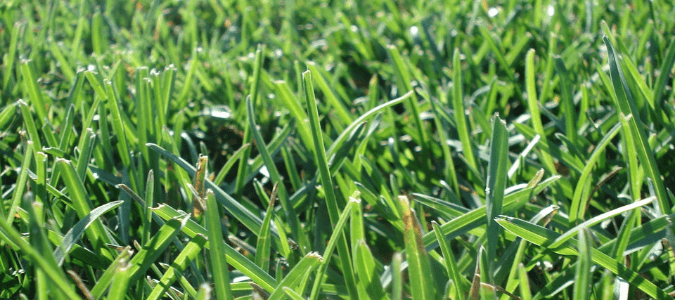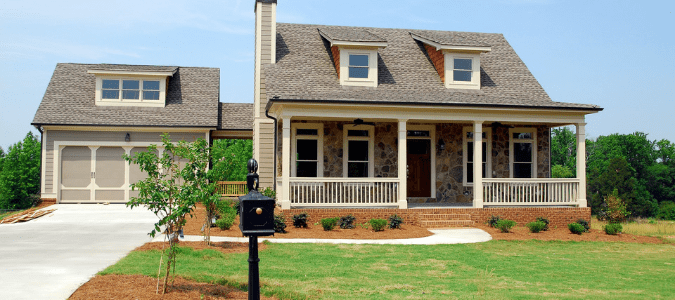Choosing the best grass for North Texas lawns depends on several factors. The main types of grass that thrive in North Texas, with its hot summers, cold winters and low to moderate precipitation, are bermuda, St. Augustine, zoysia, tall fescue and Texas blue grass. The local climate is always the first thing to think about when choosing the right variety for your yard, but the particulars of your yard itself should also be taken into account. How much of the yard is covered in shade? How much traffic does your lawn usually get? For example, do you have kids or pets who run around in the grass?
You should also think about your own level of interest in maintaining your yard. Do you mow and water regularly, or do you tend to avoid these tasks? Does the idea of aerating or fertilizing your lawn seem manageable, or intimidating? Some types of grasses require a little more care than others. Your answers to these questions will help you narrow down your choices for which type of grass is best for your North Texas lawn.
You can also take into account the type of grass you currently have in your yard, if any. Most people who are trying to decide on which type of grass to plant in their yard aren’t happy with the grass they currently have. This could mean their current grass wasn’t the right choice for their needs, but it could also mean they need to care for it differently. Many people balk at the idea of investing a lot of time on their lawn, especially springtime tasks like fertilizing, top dressing and aerating. The good news is, you aren’t alone; while these are side project that will greatly benefit your lawn, you don’t necessarily have to do them yourself. Hiring a lawn care professional to manage the details of caring for your grass will take the stress of lawn care off your plate.
People who are filling in bare spots in their lawn typically go with the same variety of grass that’s already present, for aesthetic reasons. But if you’re looking to resod your whole yard, you can choose whichever grass variety makes the most sense. Fortunately, choosing the best type of grass for your lawn shouldn’t be too difficult. Just keep in mind that there is no perfect grass; each variety has strengths and challenges. Let’s take a closer look at these grasses.
Bermuda Grass
Bermuda grass is a very common grass type found in yards across North Texas. It’s hardy as far as wear and tear, and it’s also drought tolerant. This makes it ideal for a climate where it may get very little rain in some years. Most varieties of bermuda grass do prefer sun, so it may not fare well in yards with lots of tree cover. Some people also don’t like the invasive quality of bermuda. It has a tendency to spread wherever it can, including into flower beds and paths. Also, because of its deep root structure, it can be tough to eliminate. That can mean that with bermuda grass, you’ll likely have to put more effort into keeping grass out of your flower beds, for example.
St. Augustine Grass
St. Augustine is another common and traditional grass choice for North Texas lawns. Many people love St. Augustine for its beautiful medium green color and wide grass blades. It’s a good choice for yards with moderate shade, as it needs just a few hours a day of direct sun to thrive. It needs good drainage, so it can get water-logged in yards with too many low spots and too much shade to drain well after a heavy rain. Water-logged St. Augustine is vulnerable to root rot—a fungal disease that causes patches of yellowing and can kill off the grass over time. Also, for those rare times when it gets really cold in our area, these varieties tend to be less tolerant of temperatures below 10 degrees. Lastly, it can be more expensive to plant, since St. Augustine can only be started from plugs or sod.
Zoysia Grass
Zoysia grass can be a good choice for people who like the look of St. Augustine but need a grass that’s a bit hardier for their yard as far as foot traffic. Like St. Augustine, zoysia grass can tolerate some shade, but it has much lower water needs once it’s established. It’s a great choice for yards that get a lot of use—dogs running around, kids playing football and the like. It also tolerates both heat and cold well. Just don’t expect it to keep its beautiful emerald color throughout the year; zoysia is known for turning brown earlier in the fall than some other grass varieties, and greening up later in the spring. Zoysia can also be a bit more expensive than other grasses since it has to be planted with sod or plugs, and is not readily available in seed form. It also takes time to get established and grow thickly—often two to three years.
Tall Fescue and Texas Blue Grass
Tall fescue and Texas blue grass are both good choices for yards with lots of shade, but keep in mind that neither grass type is very heat tolerant. Even in a very shady yard, both types can wilt dramatically in summer. Fortunately, they do typically bounce back when temperatures start to drop again in the fall. Both of these grass types also stay green through the winter, which many homeowners love for aesthetic reasons.
All grass varieties do best when they receive the right care. This means not just regular mowing and watering throughout the growing season, but also fertilizing and aerating at the right times of year to help the grass thrive. Warm-season grasses like St. Augustine and bermuda, for example, should be aerated and fertilized earlier in the year than cool-season grasses like tall fescue.
Weed control can be an issue with any type of grass that isn’t well cared for. The most effective weed control is keeping your lawn growing thickly so weeds can’t poke through the thatch. A reputable lawn care professional can help keep your lawn lush, healthy and weed-free by establishing a lawn maintenance schedule that is tailored to your yard.
If you aren’t sure what type of grass you have growing in your yard, it’s important to know how to identify grass type so you can be sure to care for your lawn in the best ways to help it grow and be healthy. This is especially true if your lawn is struggling—if there are bare or discolored patches, for example, or lots of weeds. Knowing which type of grass you have will determine how often you should be mowing and watering, when to fertilize and aerate the lawn, and other factors that will help keep your outdoor spaces looking lush and green.
How to Identify Grass Types in Your Yard
In a North Texas yard that has either full sun exposure or partial shade, there’s a good chance that you have either bermuda, St. Augustine or zoysia grass, because these are the grasses that thrive in hot, sunny conditions. If your yard has a lot of shade, on the other hand, it might be planted with tall fescue or Texas blue grass.
Of course, if your lawn is struggling, it may be because the wrong type of grass was planted for your yard’s particular conditions. That’s when knowing how to identity grass type really comes in handy. If your grass has a wider blade with rounded tips and a medium green color, it may be St. Augustine. St. Augustine, pictured above, grows quickly during its growing season (spring through fall) and can grow quite tall if it isn’t mowed regularly.
While zoysia grass is sometimes confused with St. Augustine, it is usually a darker green color, with softer, finer blades. It’s also slower-growing than St. Augustine, and doesn’t need to be mowed as often.
If your grass has narrower, darker green, more pointed blades, and if you notice that it grows quickly in spreading runners that root deeply into the ground, there’s a good chance it’s bermuda grass. Bermuda grass grows lower to the ground, even when it isn’t mowed often.
If you aren’t sure what type of grass you have growing in your yard or how best to care for it, contact a lawn care specialist. These professionals can make an accurate identification of the exact variety of grass you have, and based on that can recommend best practices for growing a healthy lawn. If your lawn has bare or discolored patches or weeds, a professional can address those issues and restore your yard to its best condition.
A professional can also determine if your grass is dead or dormant. However, there are some things you can check yourself to determine if you can revive your grass or if it will need to be replaced.
Dormant Grass versus Dead Grass: What’s the Difference?
If you have brown, dead-looking grass in your yard, you might think it’s time to get the entire lawn redone—but don’t be too quick to make a potentially costly decision. It can be hard to tell the difference between dormant grass and dead grass, but if you know what to look for, you can make a more informed decision about how to proceed. That might mean nurturing and protecting dormant grass through to a healthy growing season, or it might mean replacing dead grass with new landscaping of your choosing.
When trying to determine whether grass is dead or dormant, your first clue can come from the season. Is it fall, winter or early spring? If so, there’s a strong chance that grass that appears to be dead is really just in its dormant phase. If it’s during the warmer months, from late spring through early fall, dead-looking grass might really be dead—unless it’s the height of summer, and low water conditions plus heat from the sun has “burned” the grass to a tan color.
Whichever grass variety you might have in your yard, it should green up in spring and through at least the early part of summer. If parts of it are green but other parts are yellow, tan or brown, it may not be dead, but it is likely struggling. A lawn care professional can diagnose any potential issues with insects, fungal diseases or nutrient deficiencies and recommend a treatment plan.
The next clue to look for to determine whether grass is truly dead is whether the discolored areas are smaller and patchier, or more widespread and uniform. Widespread, uniform discoloration in grass could mean it is dead or dying, or possibly dormant due to lack of water. Smaller yellow, tan or brown patches, on the other hand, could signify the presence of insects like chinch bugs or grub worms, or fungal rot that is leaching nutrients from the roots.
Hiring a lawn care professional to determine whether your grass is dead, dormant or struggling is often the most efficient way to get your lawn back on track, so you can enjoy a healthy green lawn once again.
ABC Can Keep Your Lawn Healthy and Looking Great
Instead of struggling with grass that just isn’t working for you, contact ABC Home & Commercial Services. Our highly-trained lawn care team can give suggestions on which grass varieties will work best for your yard. And, we can maintain your yard and landscaping, so you don’t have to put in any of the hard work yourself.



